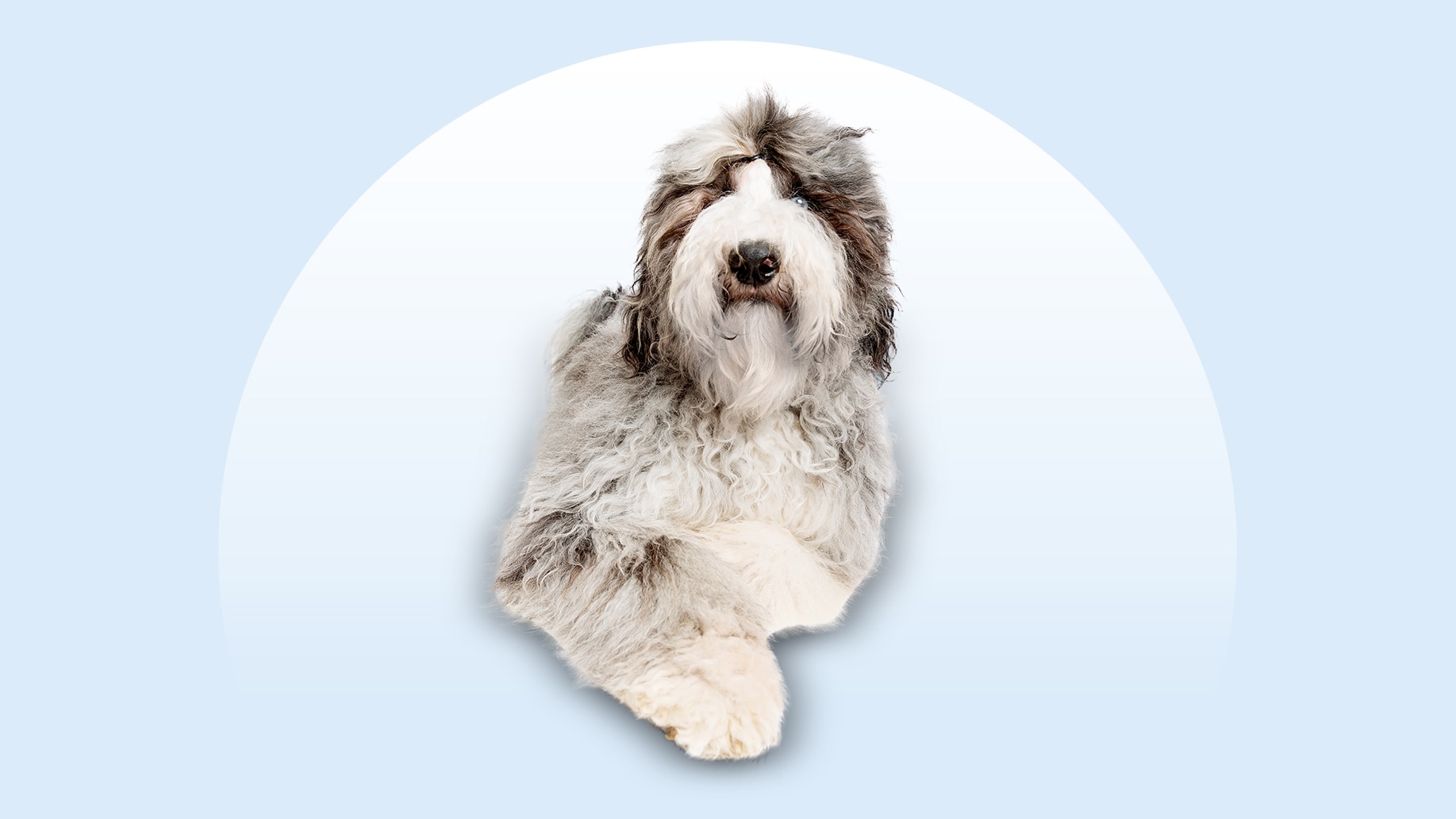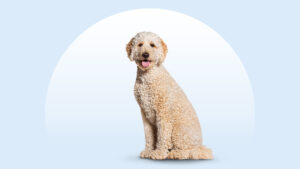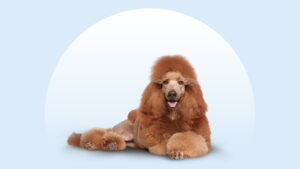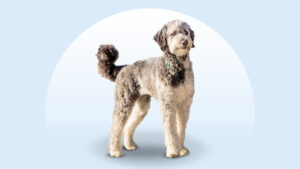Sheepadoodle
Updated July 8, 2025
Sheepadoodle
Updated July 8, 2025
The Sheepadoodle—a mix of an Old English Sheepdog and a Poodle—doesn’t just bring together two of the most striking coats in the canine kingdom; the cross also combines two of the most beloved personalities. The result? An irresistibly furry and fun family dog with high play and grooming needs.
Brainy, Affectionate, Playful
Standard: 65–85 pounds
Miniature: 25–45 pounds
Standard: 16–22 inches
Miniature: 15–20 inches
12–15 years
Black, Blue, Cream, Gray, White
If you’ve ever wondered what it would be like to share your home with a living, breathing teddy bear, look no further than the Sheepadoodle, a fluffy Old English Sheepdog–Poodle mix.
The Sheepadoodle’s long, wavy locks are easy on the eyes but not on the grooming routine, so expect to spend quality time brushing your pup every day. If you’d like less coat to care for, you might prefer a Mini Sheepadoodle, which is a cross between an Old English Sheepdog and a Miniature Poodle. They offer all the perks of their standard-sized counterparts in a more compact companion.
In addition to sporting the cuddliest coat, Sheepadoodles have a mind and body built for play. You’ll need to schedule time for exercise, training, and mental stimulation, too.
Sheepadoodle Characteristics
Sheepadoodle Appearance
Because Sheepadoodles don’t have a breed standard, their appearance is less predictable than other established dog breeds. But they typically have long, thick, wavy fur with a black-and-white pattern, like an Old English Sheepdog with a perm.
This fur tends to extend to a Sheepadoodle’s endearingly floppy ears and often obscures their dark, friendly eyes. But regular grooming visits (and using hair ties) can help improve their vision!

- Ears
Sheepadoodle ears hang long and loose.
- Eyes
Sheepadoodles have warm, dark eyes that exude friendliness—that is, if you can see them behind all that fur!
- Nose
The Sheepadoodle’s large black nose provides plenty of boopable real estate.
- Coat Length
Their long, thick coat typically sheds less than that of an Old English Sheepdog, which can be better for people with allergies. (But some Sheepadoodles do shed!)
- Coat Color
Sheepadoodles typically sport a black and white coat, like their Old English Sheepdog parent, but other coat colors like gray, blue, and cream are possible.
- Tail
They may inherit a natural bobtail from their Old English Sheepdog parent or have a long tail.
Sheepadoodle Temperament
The Sheepadoodle’s parent breeds were both bred to work, and their offspring have the wits, athleticism, energy, and training aptitude to prove it. However, that doesn’t mean they can’t excel as family pets, too—just be sure to give them a daily “job” (like exercise) and plenty of attention.
Every dog is different, but properly socialized and trained Sheepadoodles are every bit as fun and loving as they look. They’re quick to make friends with people of all ages, though very small children may not be ready for a dog of their size and zest. Sheepadoodles can even pal around with other pets—cats included.
Once your Sheepadoodle dog is good and worn out, you can expect a ready and willing cuddle partner who’s equipped with the perfect coat for maximum coziness.
How to Care for a Sheepadoodle
Sheepadoodles are dogs with big hearts and big appetites for exercise. Both their body and their brain need a daily workout.
The Sheepadoodle’s thick, wavy coat is a work of art—emphasis on work. But on the plus side, you couldn’t ask for a more lovable dog to groom. Your daily upkeep sessions will be one-on-one time well spent.
Grooming
Training
Diet
Exercise
Environment
Sheepadoodle Health
The average Sheepadoodle lifespan is 12–15 years. They’re considered a generally healthy crossbreed, but like all breeds, they’re predisposed to certain health conditions.
Partnering with your veterinary team to monitor your pet for signs of common problems is an important part of caring for your Sheepadoodle pup.
- Bloat: Bloat in dogs occurs when gas and/or food cause the stomach to expand. Sometimes, bloat progresses into a condition called gastric dilatation-volvulus (GDV), in which the dog’s stomach twists and cuts off blood flow to and from the stomach and the spleen.
- GDV is painful and a life-threatening emergency, and the signs include retching or dry heaving without vomiting, swollen abdomen, sudden anxiety, pacing, panting, drooling, and collapse. If you notice any of these signs, get immediate veterinary care.
- Hip dysplasia: Hip dysplasia is a condition in which the hip joint doesn’t develop properly, and it’s characterized by a looseness that leads to arthritis if left untreated. Mild cases are treated with interventions like physical therapy and joint supplements, while severe cases may require surgery.
- Progressive retinal atrophy: Progressive retinal atrophy (PRA) is when the rods and cones of the retina deteriorate. Signs of disease include a reluctance to enter dark spaces, clumsiness, and cataracts. There’s no cure for PRA, and the condition eventually leads to blindness.
Sheepadoodle History
While the Sheepadoodle crossbreed is a relatively new creation—likely originating around the 1990s—the parent breeds’ origin stories go back hundreds of years.
Old English Sheepdogs have a misleading moniker. First developed in the 18th century, they aren’t an ancient breed. Nor are they fully English, as they likely have some Scotch, European, and Russian ancestors. And finally, they aren’t even sheepdogs; they were mainly used to move cattle from fields to markets.
Poodles have their own muddled history, because while they may be the national dog of France, the breed was developed in Germany. And though their elegant appearance eventually made them a popular choice for wealthy French households, Poodles were originally bred to be duck retrievers.







